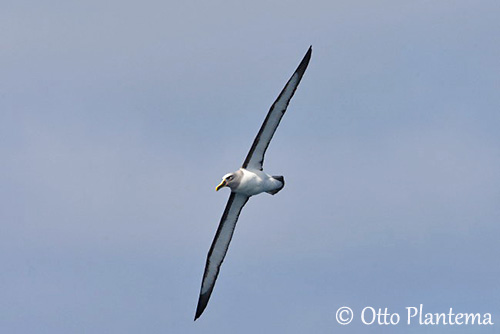
Fr: Albatros de Buller
All : Bulleralbatros
Esp : Albatros de Buller
Ital : Albatro di Buller
Nd: Bullers Albatros
Sd: Vitpannad albatross
Photographer:
Otto Plantema
Trips around the world
Text by Nicole Bouglouan
Sources:
HANDBOOK OF THE BIRDS OF THE WORLD vol 1 by Josep del Hoyo-Andrew Elliot-Jordi Sargatal - Lynx Edicions - ISBN: 8487334105
BirdLife International (BirdLife International)
New Zealand birds and birding (Narena Olliver)
Department of Sustainability, Environment, Water, Population and Communities
Wikipedia, the free encyclopaedia
Buller’s Albatross
Thalassarche bulleri
Procellariiforme Order – Diomedeidae Family
INTRODUCTION:
The Buller’s Albatross has restricted breeding range, and the highest concentration of breeding pairs is found in the Chatham Islands. This species is endemic to New Zealand where it appears relatively sedentary.
Its name pays tribute to the New Zealand ornithologist Walter Buller (1838-1906).
DESCRIPTION OF THE BIRD:
Biometrics:
Length: 76-81 cm
Wingspan: 205-213 cm
Weight: 2400-3100 g
The upperparts are brownish-black on upperwing, scapulars and back, whereas the mantle is slightly paler. Rump and uppertail-coverts are white. Tail feathers are dark greyish.
The underparts are white. On the white underwing, we can see a broad black leading edge and a narrower black trailing edge. The wing tip is black too.

The adult has ashy brown to pale grey head and neck, paler on the upperside and silvery-white on crown and forehead.
The two-tone bill is black, with yellow upper and lower ridges, including the hooked tip. There is a narrow orange line at base of lower mandible. The gape is orange too, but often concealed.
The eyes are brown, with blackish loral area and eyebrow. There is a partial white eyering with white crescent around the rear of the eye.
Legs and webbed feet are pale blue-grey and pale pinkish.
Both adults are similar.

The juvenile resembles adult, but it has slightly darker brownish-grey hood (head and neck), and duller, less contrasting crown. The bill is brownish to greyish-horn, with blackish tip.
The chick has white down overall, blackish bill and pale pink legs and feet.
SUBSPECIES AND RANGE:
The Buller’s Albatross has two subspecies, sometimes considered as separate species, with some differences in behaviour.
T.b. bulleri (here described) occurs on Solander and Snares Islands.
T.b. platei is found on Three Kings and Chatham Islands. This one shows darker head and wider bill. It is named Pacific Albatross.
HABITAT:
The Buller’s Albatross is marine and pelagic. It spends most time at sea and returns to land only for breeding.
Its breeding grounds are on remote islands. It nests on grassy slopes or among boulders, on grounds with sparse vegetation.
The nominate race nests under small forest trees of genus Olearia, a common tree in New Zealand.

CALLS AND SONGS: SOUNDS BY XENO-CANTO
The Buller’s Albatross produces several sounds such as groans, grunts and moans during displays, and performs the typical bill-clattering as well in displays as in threat behaviour.
BEHAVIOUR IN THE WILD:
The Buller’s Albatross feeds on cephalopods (squid), fish, krill, crustaceans and tunicates (Pyrosoma). It feeds by surface-seizing while floating. It may also perform shallow dives from air or from surface. Some records mention birds diving to 10 metres depth into swarms of Euphausiids at Snares Islands.
This species has been recorded following ships, and it feeds mainly during the day.

Like other Diomedeidae species, the Buller’s Albatross pairs for life. Most breeding birds arrive through December, usually mid-December, at breeding grounds, and males usually arrive first. They breed every year in loose colonies, and return to the same site.
Courtship displays are characteristic of albatrosses, and accompanied by calls and bill-clattering.
The Buller’s Albatross of nominate race “bulleri” is relatively sedentary, and only disperse to adjacent waters, and W to S Tasmania.
The race “platei” is more migratory and moves E across the South Pacific Ocean, to the west coast of South America, in the Humboldt Current, off Chile and Peru.
Take-off and landing are always difficult manoeuvres for an albatross. But once in the air, it glides along on stiff wings and can cover long distances. When it loses speed, it turns into the wind and rises again over the waves.


REPRODUCTION OF THIS SPECIES:
The breeding season starts in January for T.b. bulleri, and in October for T.b. platei.
The Buller’s Albatross forms loose colonies of less than 20 pairs, usually between 2 and 12 pairs. The nests are scattered on the ground among the sparse vegetation.
The nest is a pile of grass and mud, a truncated cone with a shallow depression at top.
The female lays a single egg, and both adults incubate during 72 days, with stints of several days. The white downy chick is fed by regurgitation by its parents. It fledges about 145 days after hatching. It will be sexually mature at 7-9 years old.
This species can live up to 30 years in wild.

PROTECTION / THREATS / STATUS:
The Buller’s Albatross is vulnerable to predation by introduced cats and rats, due to its ground-nesting behaviour. Other mammals such as rabbits, goats and pigs disturb and destroy the habitat.
This species, like numerous seabirds, is always threatened by long line fishing fleets, and ingestion of fishing hooks sometimes regurgitated to the chick which dies.
Marine pollution and degradation of both marine and inland habitat may have long-term effects on the numbers of this species. The estimated annual breeding population is about 32 000 pairs throughout the range.
Currently, the Buller’s Albatross is evaluated as Near Threatened.
